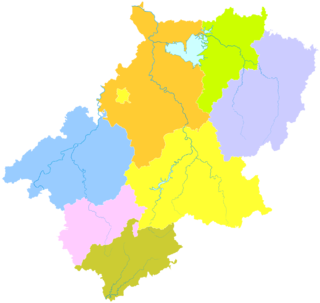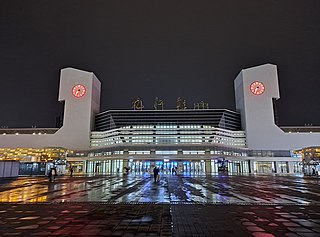
Hu Yaobang was a Chinese politician who was a high-ranking official of the People's Republic of China. He held the top office of the Chinese Communist Party (CCP) from 1981 to 1987, first as Chairman from 1981 to 1982, then as General Secretary from 1982 to 1987. After the Cultural Revolution (1966–1976), Hu rose to prominence as a close ally of Deng Xiaoping, the paramount leader of China at the time.

Jiangxi is an inland province in the east of the People's Republic of China. Its major cities include Nanchang and Jiujiang. Spanning from the banks of the Yangtze river in the north into hillier areas in the south and east, it shares a border with Anhui to the north, Zhejiang to the northeast, Fujian to the east, Guangdong to the south, Hunan to the west, and Hubei to the northwest.

Jingdezhen is a prefecture-level city, in northeastern Jiangxi province, with a total population of 1,669,057 (2018), bordering Anhui to the north. It is known as the "Porcelain Capital" because it has been producing Chinese ceramics for at least 1,000 years, and for much of that period Jingdezhen porcelain was the most important and finest quality in China. The city has a well-documented history that stretches back over 2,000 years.

Nanchang is the capital of Jiangxi Province, China. Located in the north-central part of the province and in the hinterland of Poyang Lake Plain, it is bounded on the west by the Jiuling Mountains, and on the east by Poyang Lake. Because of its strategic location connecting the prosperous East and South China, it has become a major railway hub in Southern China in recent decades.

Jiujiang, formerly transliterated Kiukiang or Kew Keang, is a prefecture-level city located on the southern shores of the Yangtze River in northwest Jiangxi Province, People's Republic of China. It is the second-largest prefecture-level city in Jiangxi province.
Lianxi is a district in Jiujiang, Jiangxi, China. It was formerly named Lushan District, taking its name from Mount Lu, which was located inside its boundaries. In April 2016, jurisdiction for Mount Lu and Guling town was transferred to the newly renamed County-level Lushan City, and Lushan District was renamed as Lianxi.

Fuzhou is a prefecture-level city in the northeastern part of Jiangxi province, People's Republic of China.

Jixi County is a county under the administration of the prefecture-level city of Xuancheng, in the southeast of Anhui province, China, bordering Zhejiang province to the east. It has a population of 180,000 and an area of 1,126 km2 (435 sq mi).. Jixi County is a hilly region with many rivers and bodies of water.

De'an is a county under the jurisdiction of the prefecture-level city of Jiujiang in the north of Jiangxi Province, China. Its total area is 939.40 km2 (362.70 sq mi), and the population is 166,000 as of 2010. This county is known for the residence of the parents of film director Ang Lee as well as fashion designer, model, and actress Lü Yan.

Yongxiu is a county under the administration of Jiujiang City in northern Jiangxi province, People's Republic of China, on the western shores of Poyang Lake. As of 2005, the county has a total population of 361,000 residing in an area of 2,035 square kilometres (786 sq mi). Bordering counties are Duchang, Xingzi, De'an, Wuning, Jing'an, Xinjian, and Anyi, while the county seat is 40 kilometres (25 mi) north of Nanchang, the provincial capital, and 80 km (50 mi) south-southwest of downtown Jiujiang.

Jiujiang railway station is a railway station located in Jiujiang, Jiangxi province, eastern China.

Gongqingcheng railway station is a railway station located in Gongqingcheng, Jiujiang, in Jiangxi province, eastern China. It serves the Beijing–Kowloon railway and Nanchang–Jiujiang intercity railway. The station is accessed by Jiuxian Avenue and close to the G70 Highway.

Nanchang railway station is a railway station located in the city of Nanchang, in Jiangxi province, eastern China.
The Tongling–Jiujiang railway or Tongjiu railway, is a single-track railroad in eastern China between Tongling in Anhui Province and Jiujiang in Jiangxi Province. The line is 251 km (156 mi) long and follows the south bank of the Yangtze River. Major cities and towns along route include Tongling, Chizhou, Dongzhi County, Pengze, Hukou County and Jiujiang.

The Wuhan–Jiujiang railway or Wujiu railway, is a double-track, electrified railroad in central China between Wuhan in Hubei Province and Jiujiang in Jiangxi Province. The line is 258 km (160 mi) long and follows the south bank of the Yangtze River from Wuchang District in Wuhan to Lushan Station in Jiujiang. Major cities and towns along the route include Wuhan, Huarong, Huanggang, Ezhou, Huangshi, Daye Yangxin, Ruichang and Jiujiang.

The Nanchang–Jiujiang intercity railway is an intercity high-speed railway operated by China Railway Nanchang Group, connecting Nanchang and Jiujiang, in Jiangxi Province, China. It is the first newly constructed high-speed railway in Jiangxi Province.

Xiangtang–Putian railway or Xiangpu railway, is a Class I higher-speed railway in eastern China linking Nanchang and Fúzhou (福州), the provincial capitals, respectively, of Jiangxi and Fujian Province. The line is named after Xiangtang, a township south of Nanchang, which was originally slated to serve as a terminus, and Putian, on the coast of Fujian, at which the southern branch of the Xiangpu railway terminates. The line actually begins at the Lehua East Station, a rail junction for the Beijing–Kowloon and Nanchang–Jiujiang intercity railways north of Nanchang. The line heads south to Nanchang West Railway Station and bypasses Xiangtang on its way to Fǔzhou (抚州). After entering Fujian, the line forks at Yongtai with the northern fork heading to Fúzhou (福州) and the southern fork going to Putian. The Nanchang to Yongtai section of the line plus the northern fork to Fuzhou is officially named the Nanchang–Fuzhou or Changfu railway. The southern fork is officially named the Yongtai–Putian or Yongpu railway.

The Jiujiang–Quzhou railway is an electrified railway in China. The line is 333 kilometres (207 mi) long and has a design speed of 200 kilometres per hour (120 mph).
Nanchang–Jingdezhen–Huangshan high-speed railway is a high-speed railway currently under construction in China. The railway is 289.9 kilometres (180.1 mi) long and has a design speed of 350 kilometres per hour (220 mph). It is expected to open in 2023.
The Nanchang–Jiujiang high-speed railway is a high-speed railway currently under construction in Jiangxi Province, China. The railway will have a design speed of 350 kilometres per hour (220 mph). It is part of the Beijing–Hong Kong (Taipei) corridor.
















